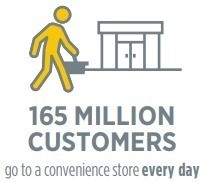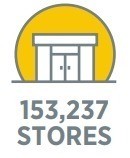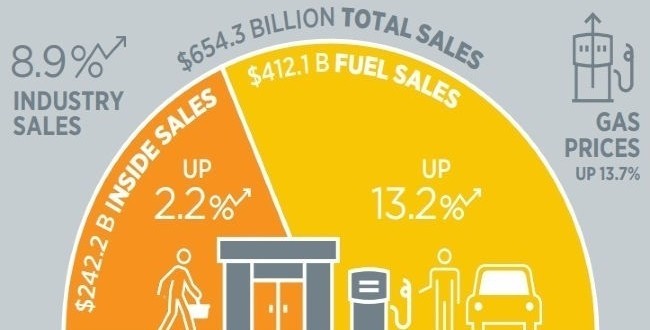
It looks like things are looking up at the corner convenience store these days according to a recent annual report of the NACS.
Convenience stores sales make up 3.1% of US gross domestic product of $20.5 trillion and despite increasing costs, record in-store and fuel sales led to last year’s positive industry growth.
2018 US convenience store industry highlights

In a news release, NACS highlighted the industry’s key 2018 results:
- total sales grew 8.9%, reaching $654.3 billion
- in-store sales grew 2.2%, a record $242.2 billion
- fuel sales increased 13.2% with margins up 7.5%
- pretax profit was $11 billion, a 5.8% increase
- the number of stores decreased by 1.1% to 153,237.
Fuel totaled $412.1 billion or 69.6% of sales while in-store sales were $242.2 billion or 22.6% of sales.
Category sales insight

The NACS report provided insight into the largest in-store sales categories for convenience stores, including cigarettes (31% of sales); food service, including prepared food and hot and cold beverages (22.2%); packaged beverages such as soft drinks, water, juices and sports drinks (15.3%); candy and snacks (10.4%); other tobacco products (6.7%); beer (6.3% total and 12.4% for stores able to sell beer); and other sales (7.7%).
Overall, convenience stores served more than 165 million customers daily in 2018 with 83% of products consumed within one hour of purchase.

There were 153,327 stores of which 97,643 were individual store operators. The industry employed 2.36 million staff, down 0.84% from 2017, with wages up 4.4% and averaging $10.74 hourly.
Costs rising too
While pretax profits for the industry rose 5.8%, the picture wasn’t all positive as operational costs continue to rise for convenience stores.
“The cost of growth, whether it’s higher acquisition multiples, new store construction or retrofitting older sites, has never been higher in our industry,” said Andy Jones, NACS vice chairman of research and president/CEO of Sprint Food Stores. For example, the average cost to build a new store has increased over the last five years from $5.6 million to $7 million. “These are business trends that convenience retailers should be prepared to address as they continue evolving and growing their businesses.”

One rising cost of big concern is the cost of credit card processing, which cost the industry $11.1 billion, an increase of 9.9%.
Despite the rising cost of overall operations, it’s a relatively positive picture for the convenience store industry which sharply defines some aspects of American retail and lifestyle.
Visuals courtesy NACS








LET’S CONNECT